|
Play List: 4. Corinne 7. The Mormons 9. Lucy Brandon 10. Storm-Beaten 11. Lady Clare 13. Bachelors 14. Constance 15. Lottie 16. Agnes 17. Alone in London 18. Sophia 19. Fascination 20. The Blue Bells of Scotland 21. Partners 24. Angelina! 25. The Old Home 26. A Man’s Shadow 27. Theodora 29. Clarissa 30. Miss Tomboy 32. Sweet Nancy 33. The English Rose 36. Marmion 37. The Gifted Lady 38. The Trumpet Call 39. Squire Kate 40. The White Rose 42. The Black Domino 44. The Charlatan 45. Dick Sheridan 47. Lady Gladys 48. The Strange Adventures of Miss Brown 49. The Romance of the Shopwalker 52. Two Little Maids from School ___ |
|
ROBERT WILLIAMS BUCHANAN (1841 - 1901) |
|
|
|
|
|
|
|
|
5. When Knights Were Bold - Reviews, etc. (4) |
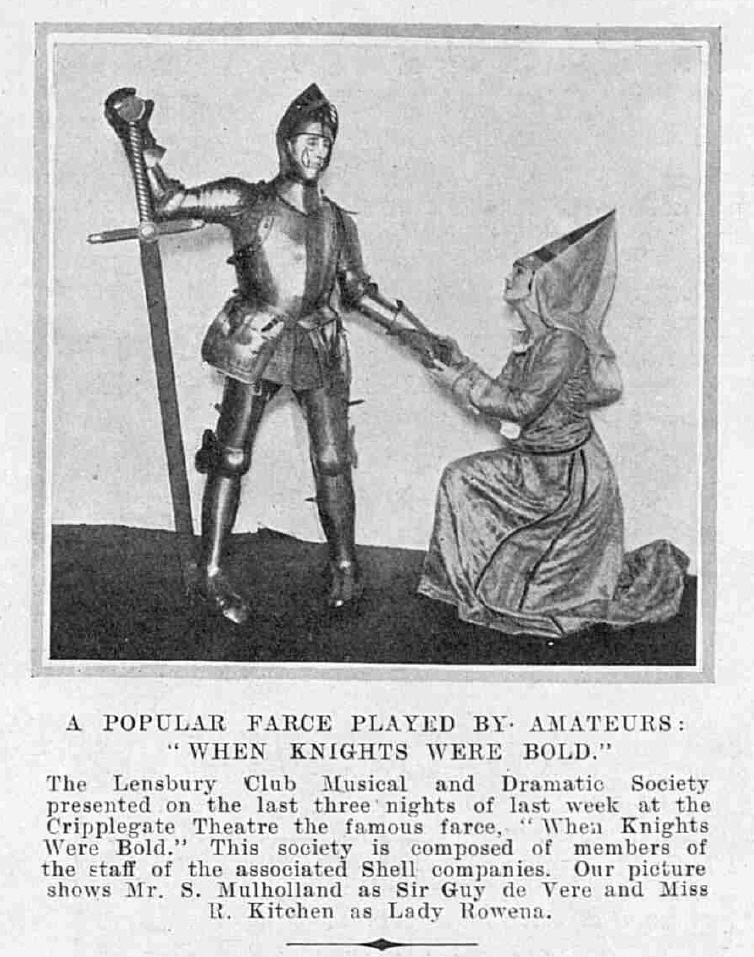 |
|
[From The Illustrated Sporting and Dramatic News (28 November, 1925 - p.68).]
The Times (23 December, 1926 - p.8) NEW SCALA THEATRE. “WHEN KNIGHTS WERE BOLD.” Much play is made during this farce with a jest that Noah is supposed to have uttered during his cruise. One suspects that the general type of humour shown in the piece was already a precious memory to him when he embarked. But broad and venerable fun is not unpardonable at pantomime time; anyhow, the hearty audience at Mr. Bromley Challenor’s latest revival of Sir Guy de Vere’s burlesque adventures in the Middle Age had no complaint to proffer. We would only suggest that it seems hardly needful to underline the author’s points quite so loudly and industriously. For those who instinctively shiver a little when the institutions of chivalry and the shade of Sir Walter are thus handled, the only consolation is that (in England) such mockery usually disguises reverence. ___
Programme for the New Scala Theatre, 22nd. December, 1926. ___
The Stage (30 December, 1927 - p.30) CHRISTMAS PLAYS. THE SAVOY. “WHEN KNIGHTS WERE BOLD.” That popular all-the-year-round as well as Christmas show “When Knights were Bold” has, after all, managed to find a West End home these holidays, Mr. Bromley Challenor opening with it once more with a matinée, at the Savoy, on December 22, Harriett Jay’s farce then going into the evening bill, and the afternoons being reserved for Mr. Hugh Marleyn’s production of another welcome visitor, “Alice in Wonderland.” Mr. Bromley Challenor and his son Derek are, respectively, director and manager, and assistant manager, for Famous Plays Syndicate, by which the Charles Marlowe “Dream of Ye Goode Olde Tymes” is being presented. The latter now plays the manservant Wittol, and the former, of course, resumes the rôle of Sir Guy de Vere, which since James Welch’s death he has made his own. Mr. Challenor still embroiders his performance with those simian and Calibanesque manifestations which thousands of amusement-seeking playgoers have enjoyed so vastly of late years. As aforetime, he is most funny of all in the second act, with the plunge 731 years backward to the Battlements, 1196. Here, with as picturesque display of mediæval pageantry as of old, we see the originally feeble Sir Guy performing doughty deeds in complete steel against the suitably truculent Sir Brian of Mr. Arthur Jenner, and rescuing from that ruffian fair ladies in distress. ___
Daily Express (18 January, 1928 - p.11) Actor’s Long, Long Trail. Bromley Challenor starts off again on his tour of England next Monday. For twelve Christmases, now, he has come to London with “When Knights Were Bold,” which he has produced at ten different theatres. He arrives in London just before Christmas, and then, after trying to find a play suited for the West End, goes on the road, after six weeks in the city of his dreams. Two Plays a Day. Two years ago Challenor played in “When Knights Were Bold,” at the Princes, in the afternoons, and in “Are You a Mason?” at the Fortune, every evening. ___
Daily Express (6 November, 1928 - p.9) Motorists in “When Knights Were Bold.” A production such as “When Knights Were Bold,” which is being undertaken this week by the Motor Union Athletic Club (Dramatic Section) at the Guildhall School of Music Theatre, interests me greatly. It is not only a dramatic production in the limited sense; it requires a stage crowd as well. ___
The Argus (Melbourne, Australia) (17 November, 1928 - p.10) STAGE GOSSIP Author of Palace Play “Charles Marlowe” and By FIRST-NIGHTER CHARLES MARLOWE is the programme name of the author of “When Knights Were Bold,” the amusing piece which has been revived at the Palace; but there was a time when the writer was known to theatre-goers and readers not as Mr. Marlowe, but as Miss Harriett Jay, actress, novelist, and dramatist. Robert Buchanan, who wrote many novels, poems, and plays, married Miss Jay’s sister, and he collaborated with his sister-in-law in the writing of eight stage pieces. The first was “The Queen of Connaught,” founded on a novel by Miss Jay which was published anonymously and was attributed by too-knowing reviewers to Charles Reade. No objection was made to this by Reade; he read the novel, saw its possibilities for the stage, and took interest in the progress of its dramatisation. Financially the most successful of the plays in which Buchanan and Miss Jay collaborated was the melodrama “Alone in London,” which is still revived by touring companies. In the original production Harriett Jay appeared at first as the boy who has much to do with the plot, and later in the season she took the place of another actress in the leading emotional part. Though the play did remarkably well always, Buchanan, who could write much better things, regarded it with contempt. “Taking my consent for granted,” says Miss Jay in her interesting biography of Buchanan, “he sold the piece for an absurdly small sum to Messrs. Miller and Elliston, and so parted with the goose which laid the golden eggs.” _____ Buchanan made large amounts by the success of other pieces, but he threw thousands away in theatre speculation and on the racecourse. He began racegoing when well advanced in middle age, and ended the experience in the unprofitable way that might have been expected. Among plays by Buchanan which had long runs were those of an eighteenth-century series adapted from noted novels. “Sophia” was founded on Fielding’s “Tom Jones,” and “Joseph’s Sweetheart” was from the same author’s “Joseph Andrews.” In Australia the Brough Boucicault company did excellent work in costume pieces of this type. Miss Jay appeared in a number of London productions, and her authorship as “Charles Marlowe” proved that she knew how to keep theatre-goers well entertained. In one city or another audiences have laughed at “When Knights Were Bold” many times since 1907, the year of its first production. At the Palace they are laughing still. |
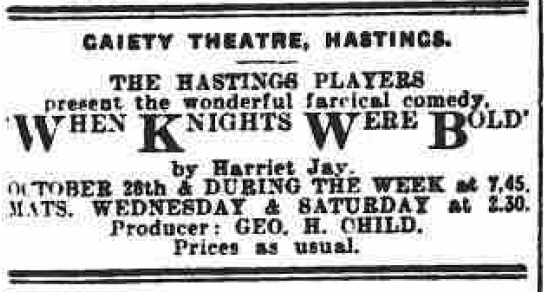 |
|
[Advert from the Hastings and St. Leonards Observer (19 October, 1929 - p.9).]
Hastings and St. Leonards Observer (2 November, 1929 - p.13) AT THE THEATRE. “WHEN KNIGHTS WERE BOLD.” ANOTHER TRIUMPH FOR THE There were people who asserted that the Hastings Players were far too ambitious in the selection of “When Knights Were Bold” for their autumn production, but they have had to admit that, although it might be an ambitious undertaking, this week’s production at the Gaiety Theatre has proved that the selection committee of the Players knew the ability of the members, for, under the guidance of Mr. George H. Child, who has many triumphs to his credit, they are playing this well-known and popular farcical comedy with unquestionable success, and one and all are deserving of the highest congratulations. ___
The Yorkshire Evening Post (16 November, 1929 - p.7) ACTRESSES INJURED. One in Grave Condition After Mr. Bromley Challenor, the actor, and members of his company, which is appearing at the Lewisham Hippodrome, London, in “When Knights Were Bold,” were involved in an alarming road accident in Lewisham High Road last night. ___
The Times (24 December, 1929 - p.10) THE PLAYHOUSE. “WHEN KNIGHTS WERE BOLD” |
|
|
|
When Knights Were Bold is simple to the point of crudity. It is based on the assumption that a confession of folly is as good as a proof of wisdom and certainly better then any pretence of cleverness. So invincible is such modesty that even when the hero is, in a dream, transported to the 12th century, he is as successful as if he had been the greatest of champions instead of an amiable imbecile of modern times. But in this revival of the play for the Christmas season its weaknesses are scarcely relevant. For the hero confesses his folly and so prepares the way for Mr. Bromley Challenor, who confesses even more clamorously and persistently, and with unflagging vivacity, that his jokes are perfectly foolish. ___
The Daily Herald (27 February, 1930 - p.5) |
 |
|||||||
|
The Times (10 December, 1931 - p.12) The hardy Christmas annual, When Knights were Bold, with Mr. Bromley Challenor in his old part of Sir Guy de Vere, will be revived this year at the Duke of York’s Theatre, where it will be presented for matinées only, beginning on Monday, December 21. Mr. Challenor first played Sir Guy de Vere in 1915, and has appeared in the part over 5,000 times. ___
The Vancouver Sun (12 December, 1931) FUN SUPREME IN PLAY AT EMPRESS Fun reigns supreme in “When Knights Were Bold,” the great comedy that holds a record in London for the number of performances in the leading theatres there. It will be produced by the British Guild Players at the Empress theatre for one week commencing today, with a matinee at 2.30 and evening 8.30 p.m. |
|||||||
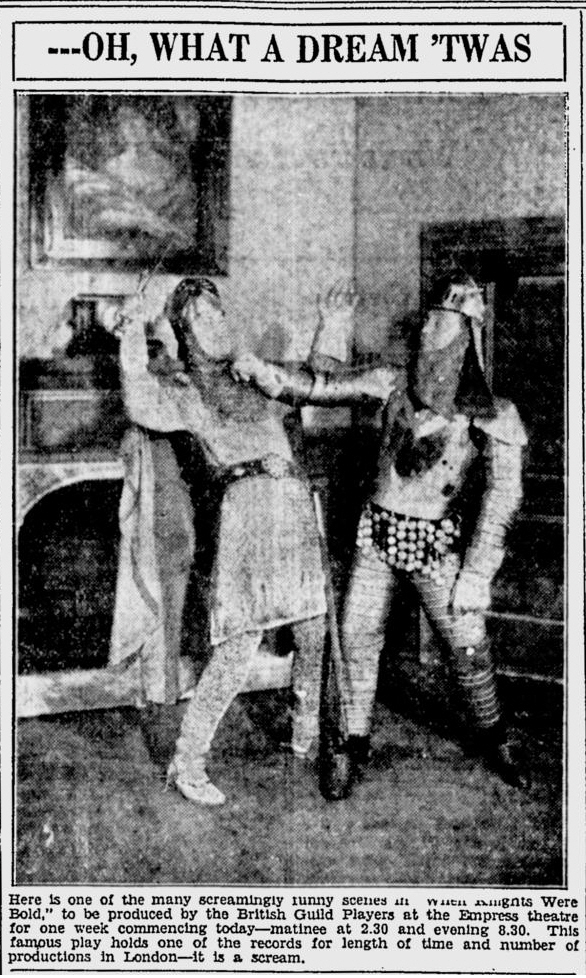 |
|||||||
|
The Times (22 December, 1931 - p.8) DUKE OF YORK’S THEATRE “WHEN KNIGHTS WERE BOLD” With slight variations in jest and circumstance When Knights Were Bold lives on. Why it should is not at first easy to be seen. In the humours of a modern knight translated into the Middle Ages there would seem no greater warrant of immortality than that of a tale well worn. Nor is there much more in the anachronisms, the puns, and the acrobatics of Mr. Bromley Challenor and his friends. The secret—if secret there be, and it be not rather a matter of the mood of an audience—is in that particular form of English humour which consists in being silly, and of which Mr. Challenor is an exponent unexcelled. ___
The Times (27 December, 1932 - p.6) FORTUNE THEATRE “WHEN KNIGHTS WERE BOLD” One good reason, among a multitude, for the revival of When Knights Were Bold each Christmas may be found in Sir Guy de Vere’s celebrated cold in the head. To those who have been suffering similarly or feel themselves about to suffer (and these two categories together compose a good majority of any winter audience) there is comfort in Mr. Bromley Challenor’s power between sneezes to wave his handkerchief into a rabbit, and magic in the manner of his falling asleep with his mustard bath untouched, only to awake an hour later without a snuffle. |
|||||||
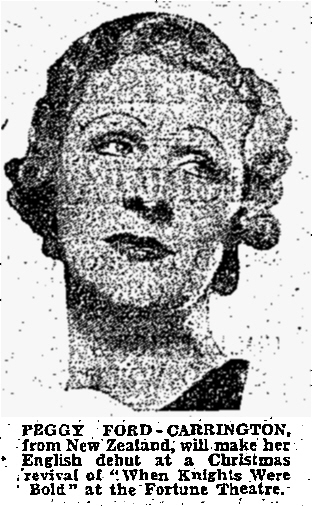 |
|||||||
|
[From the Daily Express (6 December, 1933 - p.8).]
The Times (23 December, 1933 - p.8) FORTUNE THEATRE “WHEN KNIGHTS WERE BOLD” It is obvious that the small number of really successful farces must have some quality, though it is not always easy to discover, which distinguishes them from those which last a far shorter time. To judge by this example it is the presence of an idea sufficiently robust, and sufficiently clearly presented, to stand any amount of wear and tear. For the dialogue is nothing and in this performance was readily used as a framework for gags and topical interpolations. ___
The Stage (29 December, 1933 - p.16) THE FORTUNE. “WHEN KNIGHTS WERE BOLD.” The late Harriet Jay’s long-popular piece, which has for years taken its place as one of the diverting and attractive farces of the contemporary stage, has once more been revived as seasonable holiday fare by Mr. Caspar Middleton, with the production-work shared by Mr. Jackson Hartley and Mr. Charles F. Lloyd, the latter giving an effective and not obtrusively Hebraic impersonation of Isaac Isaacson and Mr. Hartley representing Sir Guy de Vere on the familiar lines laid down by James Welch, followed and enlarged upon by Mr. Bromley Challenor with various feats in animal- impersonation performance. Brigata Bucalossi’s tuneful incidental music enhances the effect of Ye Good Old Times scenes, with foresters and coif-wearing damosels filling in the picture on the Battlements of Beechwood Towers. The effectively carried out stage management is shared by Mr. Edmund S. Phelps, who also plays Barker, butler, and Seneschal, and by Mr. Jack Morris, and the acting manager is Mr. Charles Milton. ___
The Illustrated Sporting and Dramatic News (6 January, 1934 - p.41) |
|||||||
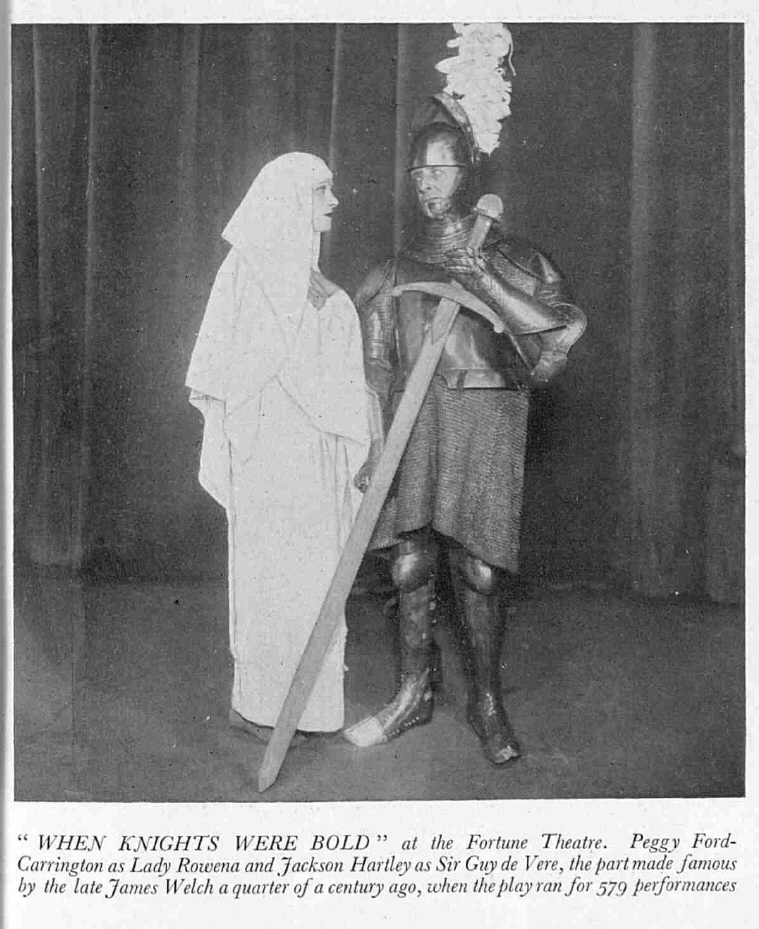 |
|
The Times (27 December, 1934 - p.6) FORTUNE THEATRE “WHEN KNIGHTS WERE BOLD” There are, we are told, only two—or is it three?—stories in the world—all the rest are merely variations of them. The Cinderella story is one, and surely the story of the man who finds himself in the wrong period of time is the other. The opportunities either for profundity or for fun are inexhaustible, and, if Mr. H. G. Wells and Henry James, to take two modern names at random, have done their bit for profundity, Mr. Charles Marlowe strikes year after year a shrewd blow for fun. ___
|
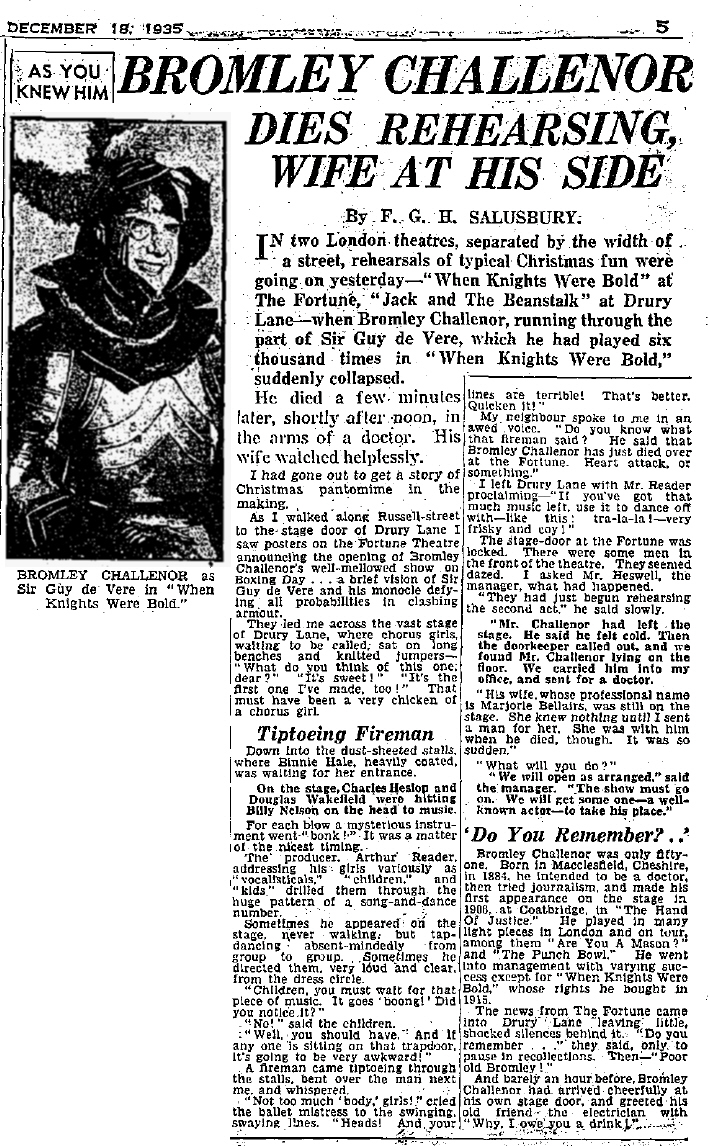 |
|
[Bromley Challenor’s obituaries are available in the When Knights Were Bold - Miscellanea section.]
Daily Express (20 December, 1935 - p.19) Advertising on the Underground still announces Bromley Challenor to play “When Knights Were Bold” at the Fortune. Jackson Hartley has taken it over. He played last year when Challenor was in Australia. ___
The Times (27 December, 1935 - p.5) FORTUNE THEATRE “WHEN KNIGHTS WERE BOLD” |
|
|
|
Certainly the moral of When Knights Were Bold would be badly missed by anyone who should draw invidious comparisons with the “good old days” of the play. James Welch and Bromley Challenor—multis ille bonis flebilis— had each his own conception of the part of Sir Guy de Vere, and even of the text of his lines. Mr. Jackson Hartley, valiantly buckling on their armour at short notice, has every right to wear it with a difference. This Sir Guy frankly tumbles through the part in the music-hall manner, or at least in that variant of it which is annually furbished up for pantomime. His colleagues automatically fall into the normal groupings of back-chat comedy, and collaborate in a rollicking, boisterous display which wins continuous laughter from that section of the audience whose recent studies predispose them to enjoy the roughest possible handling of the history book. The knockout blow on Sir Bryan’s helmet is delivered with no less crushing effect than of yore; and Sir Guy’s return to the twentieth century achieves new effects of riotous fun. ___
Pages from the programme of the 1935 production at the Fortune Theatre. ___
The Yorkshire Post (10 December, 1936 - p.8) |
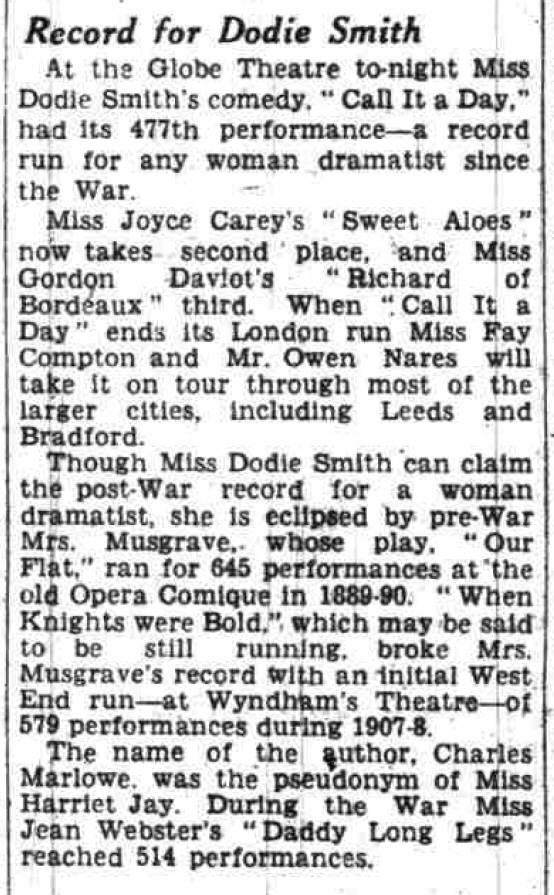 |
|
The Times (28 December, 1936 - p.15) FORTUNE THEATRE “WHEN KNIGHTS WERE BOLD” |
|
|
|
“Acts One and Three, Present Day.” But there the programme is wrong. It is true there are the modern evening dresses and a few near-topical jokes, but this is otherwise a period piece in all three acts; and when in the intervals the orchestra jumps forward into jazz it merely underlies the gap between “Present Day” and the opening years of our century, when the play was written. And, since no fashions seem quite so stale as those of the day before yesterday, so “Act Two, Anno Domini 1196,” which is the meat in the sandwich, comes fresher to the palate today than the rest of it. The players themselves are most at home on the battlements of Beechwood Towers in the twelfth century. The white nuns’ robes of the Lady Rowena and her handmaidens set off their good looks to perfection. The male members of the cast are palpably more real, more characteristically themselves, in medieval garb than in the tails or dinner jackets that belong to the present. So with the acting. If the company are adequate in modern dress they are more than adequate in the trappings of chivalry. “Dressing up” is clearly half the battle in playing the fool. ___
Programme of the 1936 production at the Fortune Theatre. ___
The Times (28 December, 1937 - p.7) FORTUNE THEATRE “WHEN KNIGHTS WERE BOLD” |
|
|
|
It is scarcely possible to understand what will make one or two, among innumerable farces survive for so many years. No doubt after a while they can live by their momentum alone, but even so it is a great mystery. As time goes on they have almost everything against them; the tempo of humour alters and quickens, a social milieu that once seemed exhilarating grows frowzy and down-at-heel, and no topical allusions—there are a good many in this production—can alter the unimaginable touch of time. But here it is at least possible to perceive some content in the farce which may have a permanent interest; there is a certain genuine criticism of life, crude enough, but quite sensible and not ungenerous, in this contrast between the present and the past. And the very simplicity of its statement at any rate ensures that the point of the play will not be missed. Moreover, the bathos of modern manners introduced among the grandeurs—here it is explicitly stated that every one in the thirteenth century spoke in blank verse—is a mysteriously lasting joke. ___
The Stage (30 December, 1938 - p.17) In presenting “When Knights Were Bold,” at the Playhouse, Newcastle, Donald Gilbert follows his usual practice in offering something different as Christmas entertainment. This delightful piece has been making a great hit since it began its fortnight’s run on Boxing Day, and as there are thrills galore and side-splitting comedy—it should suit all tastes. Desmond Walter Ellis has a part that suits his gifts for the ludicrous as Sir Guy de Vere. Alexander Gauge, Hereward Russell, Hugh Butt, Marion Brignall, Lois Sutherland, Hugh Paddick, Helen Sessions, Lawrence Rushworth, and Ross Duncan give talented support, and Alexander Gauge is responsible for the production. ___
Daily Express (9 November, 1939 - p.11) |
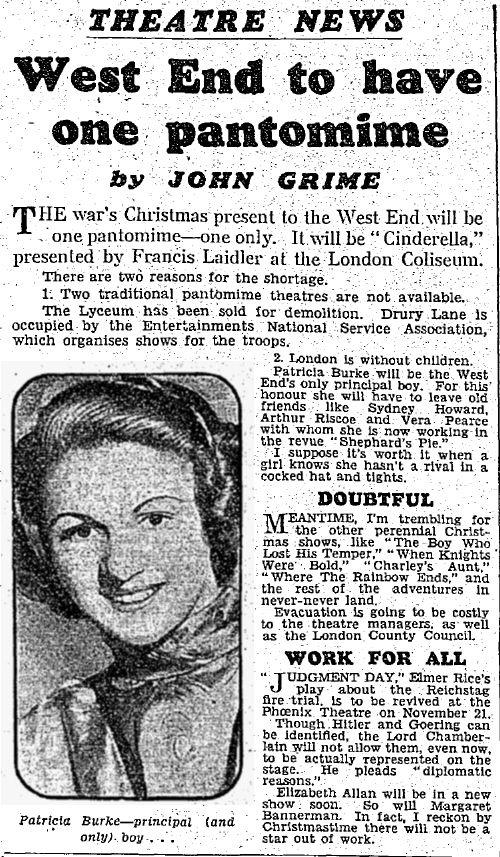 |
|||
|
[The poster below is from a Christmas performance of When Knights Were Bold at the Shakespeare Memorial Theatre in Stratford-upon-Avon. Given the order that “gas masks must be carried”, and with Boxing Day falling on a Thursday, the year must be 1940.] |
|||
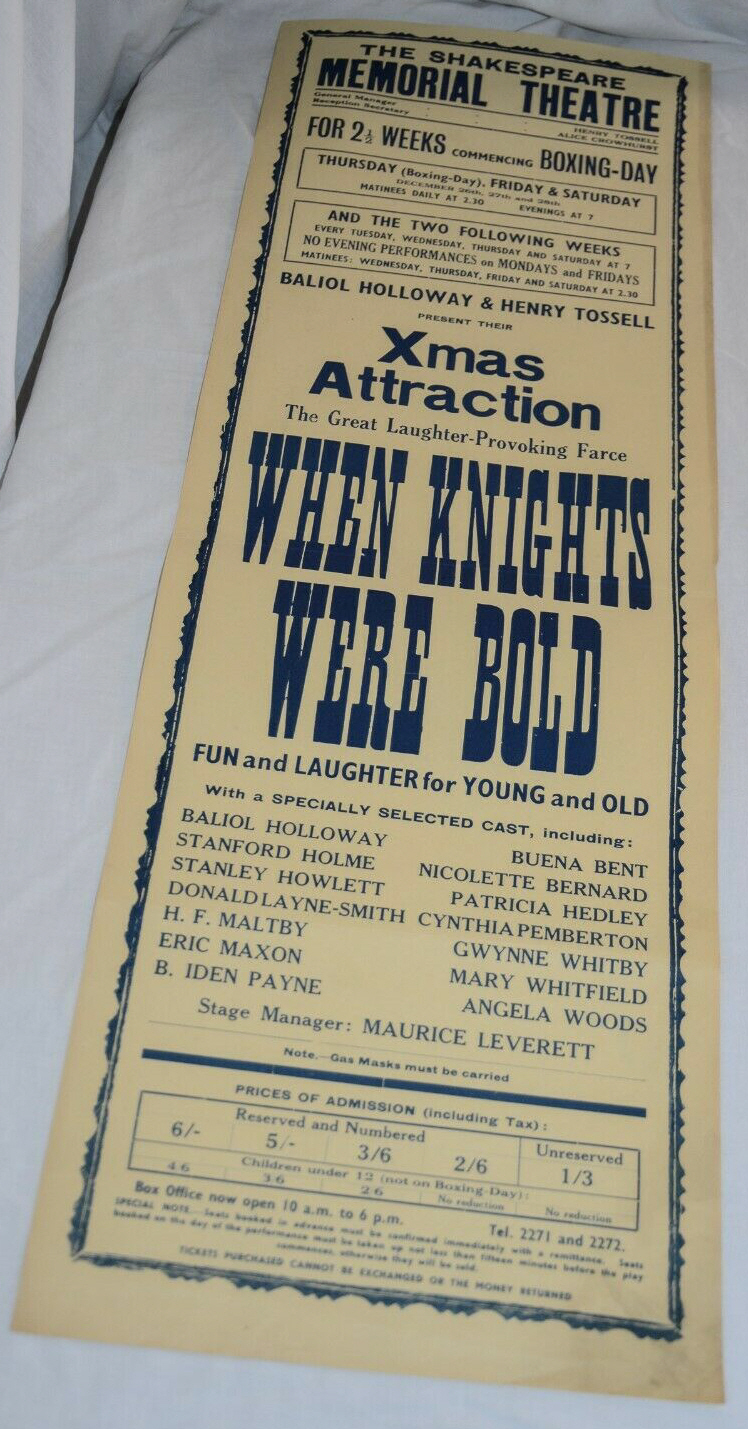 |
|
Daily Express (13 March, 1944 - p.3) Pay Corps gives ‘Box Office’ show The Leicester theatre group of the Royal Army Pay Corps came to London last night to perform “When Knights Were Bold” at the Comedy Theatre, W. ___
The Stage (29 March, 1945 - p.6) “Those . . . . Critics!” |
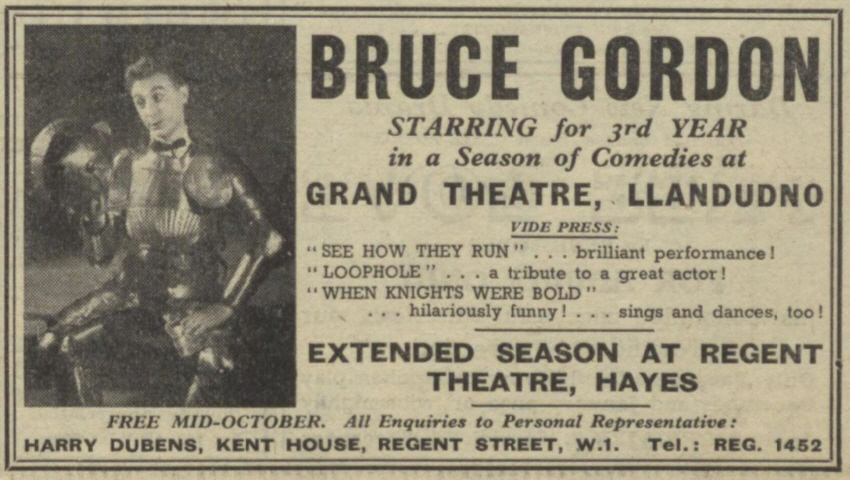 |
|
[Advert from The Stage (19 October, 1950 - p.9).]
Dundee Courier and Advertiser (25 December, 1951 - p.4) YOU’RE SURE OF A Dundee Repertory Company’s Christmas box to its patrons is chock-full of good things guaranteed to sustain the festive spirit well over the season. A FAMILY TREE LIFE AND SOUL ___
The Stage (1 January, 1953 - p.32) WOOLWICH ARTILLERY “WHEN KNIGHTS WERE BOLD” “When Knights Were Bold” is an excellent choice for the talented repertory company at the Royal Artillery. It would be easy to dismiss the play out of hand, but the piece has abounding good humour, and, what is more, humour that can be appreciated by people of nearly every age. Appearing as guest-artists are Claude Hulbert and Enid Trevor, and one suspects that the play has been tailored especially for the engagingly asinine personality of Mr. Hulbert, who plays the rôle of Sir Guy de Vere. The dialogue has largely been brought up to date, with various topical allusions, and one part, in which Mr. Hulbert attempts to make a pudding, is pure pantomime. ___
The Luton News and Bedfordshire Chronicle (8 January, 1953 - p.12) On The Stage CHARLES MAKES This week and next, the Cry of Players are presenting “When Knights Were Bold,” but they might well have called their production “When Charles Was Bold,” for Charles is the Christian name of the dominating personality of this show —Charles Workman. ___
The Stage (31 December, 1953 - p.29) MORECAMBE . . . “WHEN KNIGHTS WERE BOLD” This year’s special production at the Royalty is Charles Marlowe’s “When Knights Were Bold,” which Morecambe Repertory Theatre is presenting by arrangement with Emile Littler. This is a fast-moving and colourful production by Leonard James, who has taken full advantage of the many humorous situations provided by the script. The two amusing settings, one in pantomime-style and the other embodying the essence of Victoriana, were painted by Barry Vaughan. Heading the cast of 18 are Peter Wyatt as Sir Guy de Vere and Roma Dumville as lady Rowena Edgington, both of whom render highly spirited performances. John Dawson plays Sir Brian Ballymote, the villain of the piece, with full melodramatic gusto, and is ably supported by Peter Thorpe, who gives a clever character-study as Isaac Isaacson. ___
The Stage (31 December, 1954 - p.17) “WHEN KNIGHTS WERE BOLD” WITH a limited number of seasonable plays available the Salisbury Arts Players might have done much worse than select that now venerable comedy, “When Knights Were Bold,” for their Christmas production at the Playhouse. It gains from some refurbishing and the addition of some witty songs. These things give to the old play something of the air of an intimate revue with a plot. But in an age which knows more about bebop than bad barons the company have to work hard to conceal the joints still left in the armour; it is a tribute to the versatility of all concerned that they can convert themselves so smoothly into successful revue artists. [Note: If you want to see Peter Sellers’ Christmas message, here’s the full page.] ___
The Stage (1 January, 1959 - p.32) |
|||
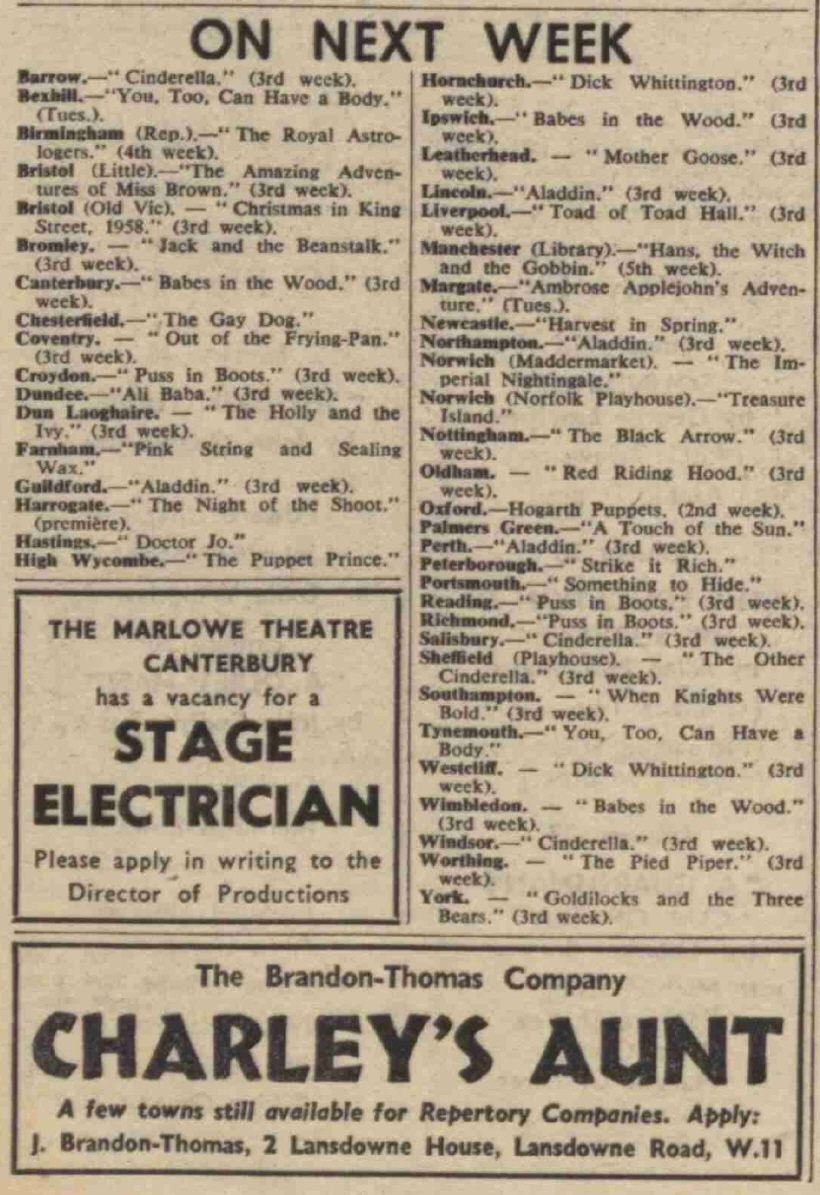 |
|||
|
Central Somerset Gazette (13 February, 1970 - p.4) [Note: I came across the following at the end of an article about the Strode Theatre’s annual pantomime. I have found no further information about the proposed new pantomime version of “When Knights Were Bold” and have assumed the project never reached fruition.] PANTO PROFIT OF £400 . . . Meanwhile, Mr. Dick Redman, who wrote the last two pantomimes is working on the musical adaptation of the comedy fantasy “When Knights Were Bold.” He has been given special permission to do this by Prince Littler. ___
The Stage (13 July, 1978 - p.9) |
|||
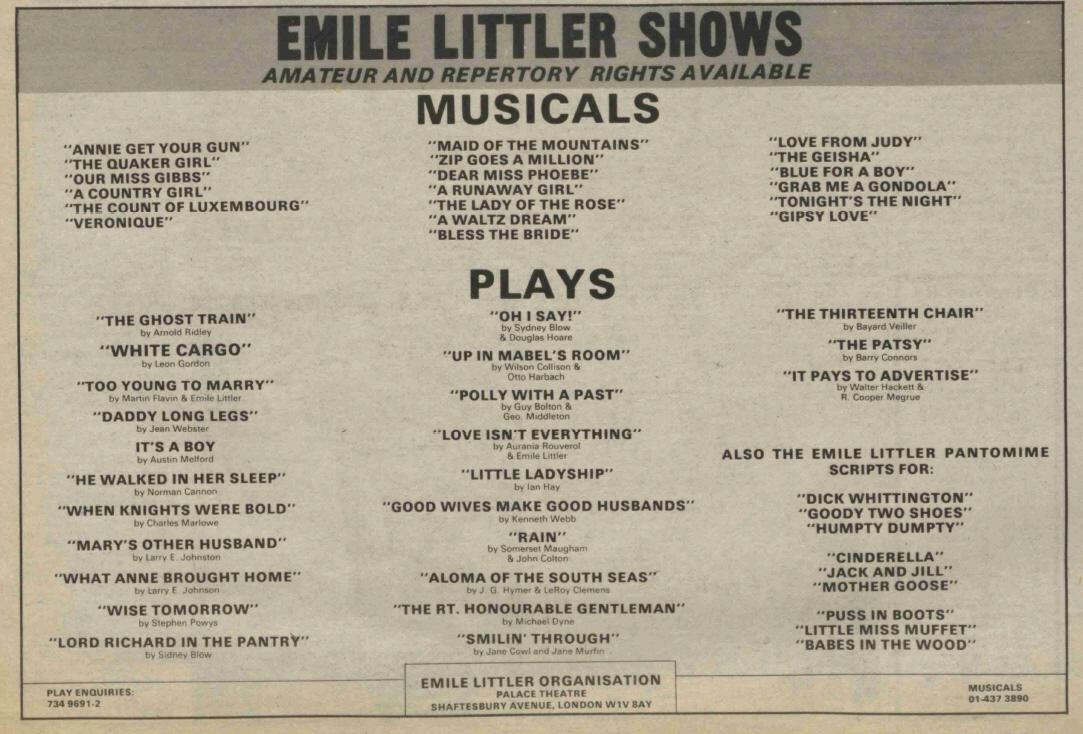 |
|
6. When Knights Were Bold in The Play Pictorial No.55 or back to When Knights Were Bold main menu
|
|
|
|
|
|
|